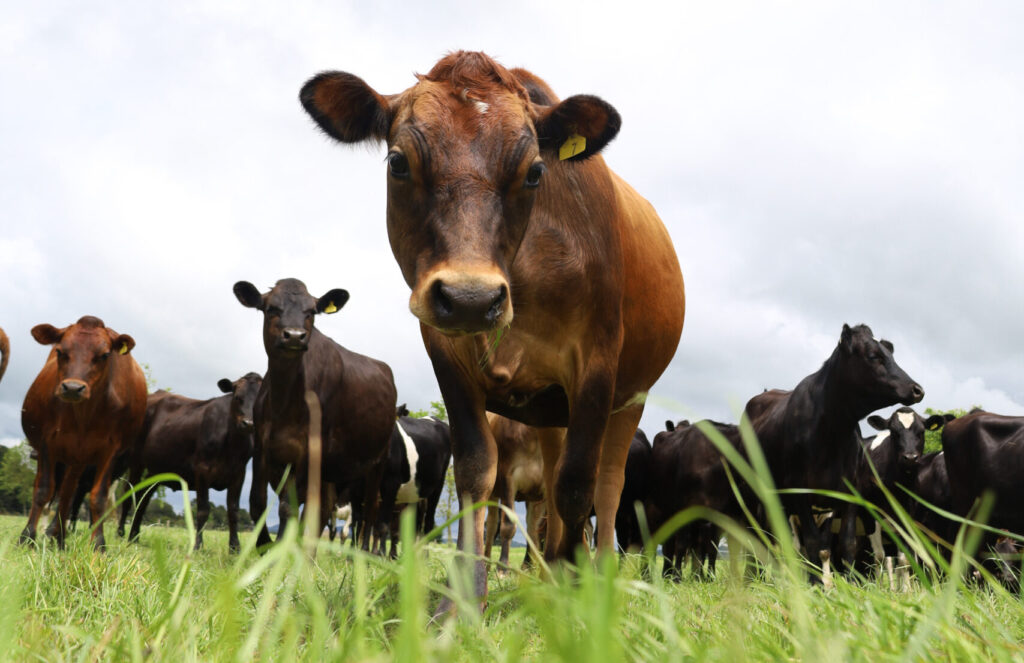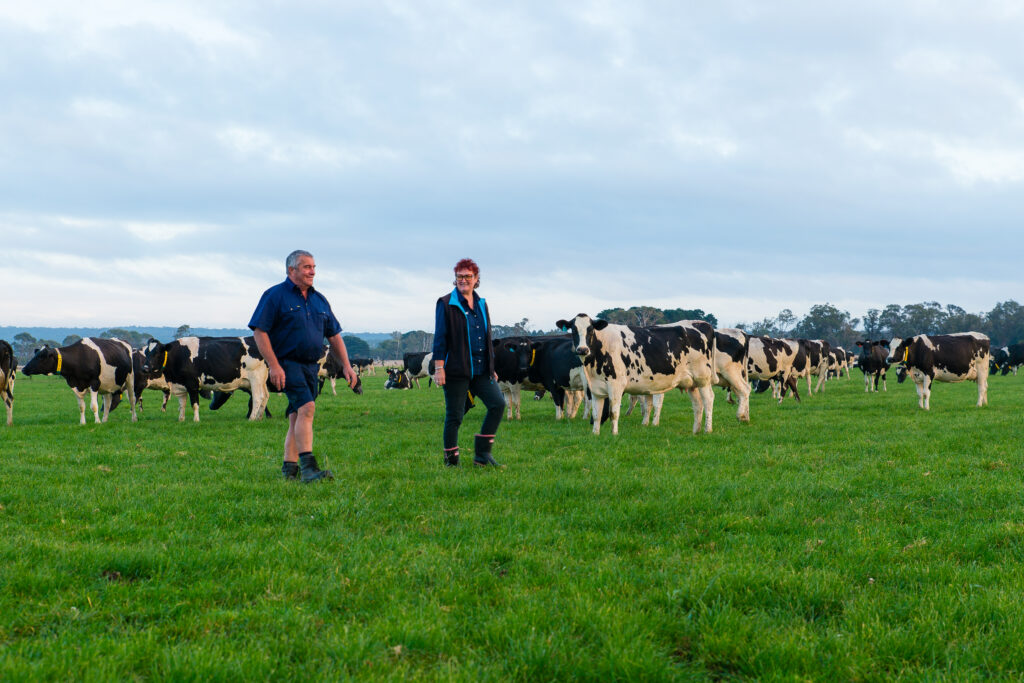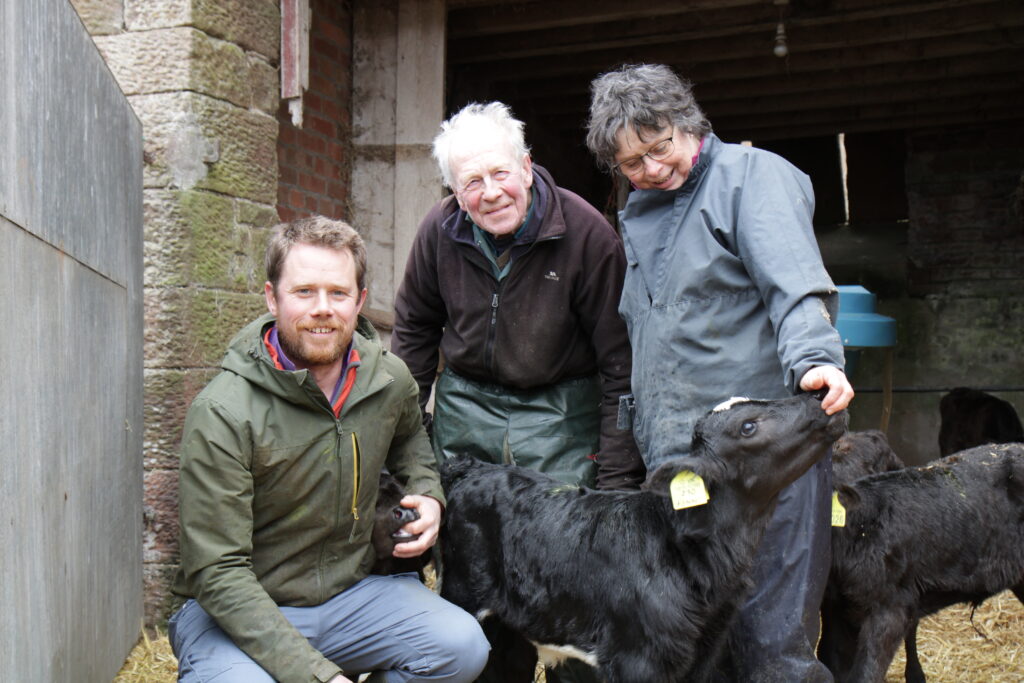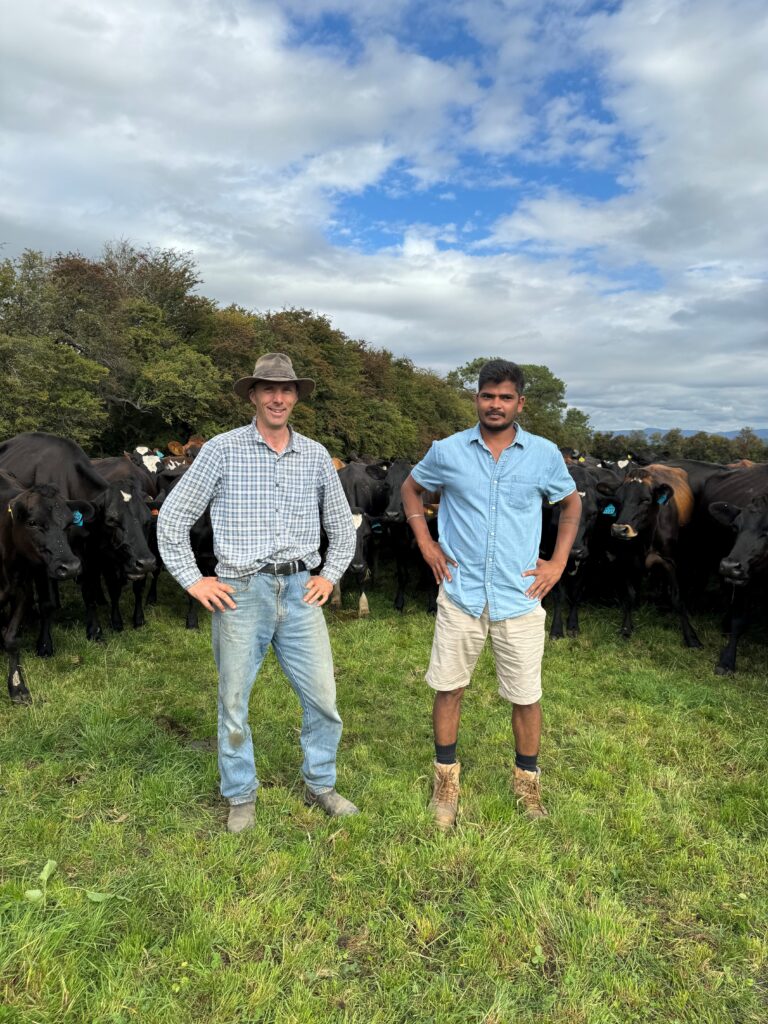Good reproductive performance comes down to how well you manage your animals throughout their whole lifetime, not just the mating season.
Stay ahead of the herd by taking a year-round approach to reproduction. This means having a clear plan for each phase, from birth to dry off.
The Ahead of the Herd reproduction tool has helpful information, objectives and tasks for each phase of a dairy cow’s life.
1. Birth
Invest in your future by investing in your herd right from the beginning – you control the factors that influence future fertility, milk production and longevity.
Objectives
- Employ skilled and empathetic calf rearers.
- Make sure there is good communication between calf rearer and other staff.
- Make sure the calf-shed feeding regime and routine is consistent and well understood.
- Staff know the herd management and calf collection protocols and keep things running smoothly.
- Maximise calf health and well-being by intervening at the correct time.
Tasks
Preparation
- Clean and disinfect the calf shed between seasons, then keep hygienic and tidy.
- Design and follow an effective policy for calf collection and admission to the calf shed.
Recording
- Identify calves (tag and record).
Health
- Make and follow an animal health plan.
- Dip or spray navels with appropriate disinfectant.
- Give each calf good quality colostrum (two to three litres within six hours of birth).
2. Rearing to weaning
The first three months of a heifer’s life are crucial.
Objectives
- Maintain a clean and hygienic calf shed throughout the calving season.
- Make sure there is good communication between calf rearer and other staff.
- Maintain a consistent, quality calf-feeding regime to guarantee optimal growth rates and rumen development pre-weaning.
- Make sure staff understand the importance of the different aspects of the feeding regime.
- Deal with health issues promptly and correctly.
Tasks
Feed
- Follow calf pen stocking and hygiene policies right through calving.
- Implement calf feeding regimes correctly.
- Check water and feed availability daily.
Health
- Monitor calf health daily and follow animal health plan.
- Isolate sick calves and follow best practice ‘hospital pen’ routines.
- Disbud calves as recommended and include pain relief.
Preparation
- Make sure a quality grazier is ready and the contract is agreed upon.
- Schedule routine animal health treatments and procedures in the diary.
- Make sure there are safe and humane calf euthanasia practices, in accordance with animal welfare codes.
3. Wean
Weaning at the appropriate time and stage is important for continued good development post-weaning.
Objectives
- Put in place a good weaning regime and make sure everyone understands its importance.
- Calves are weighed regularly and weaned once they have reached their target weight.
- The weaning protocol results in a smooth transition off milk and meal without a growth check.
Tasks
Weigh
- Know and follow the target weaning weights for different dairy breeds, or for your own animals.
- Weigh regularly and wean the calves off milk that are up to weight and eating 0.75–1kg of meal per day (where feeding meal).
- Hold back the lighter, younger calves and don’t wean until they are up to weight.
Health
- Monitor health and treat appropriately and in good time.
4. Grazing transition
Getting heifers on to the right grazing farm is important for good growth and maximising their future potential.
Objectives
- Monitor and manage calves closely for weight gain and health in the weeks after transition to the grazing block.
- Agree on and stick to a contract so heifers have the best chance possible.
- Make sure heifers meet weight targets and are healthy before they leave the home farm.
- Provide the grazier with the necessary supplies to make the transition easier.
- Find the right grazier by doing enough research.
Tasks
Feed
- Feed meal to the calves up till they leave the home farm.
- Provide the grazier with a week’s worth of meal so the transition to the new farm is smoother. If this is not practical, ensure they’re weaned off meal well before they leave for grazing and check that suitable grass is available on arrival.
Planning
- Communicate with the grazier, and check roles and responsibilities are clearly agreed.
- Discuss a trucking strategy with your advisor, especially if calves are travelling long distances.
- Ensure all movements are compliant and herd records are up to date.
Health
- Agree on a plan with your grazier and complete all treatments on time.
- Don’t send heifer calves to the grazier if they aren’t up to weight or are looking unhealthy.
- Monitor calves closely in the weeks after moving onto the grazing block and deal with any poor performing individuals promptly.
5. First year growth
The first 12 months are critical for the skeletal growth required to achieve liveweight targets at 22 months
Objectives
- Make sure there’s enough high quality pasture to achieve liveweight targets.
- Make sure rising one-year-olds are 30% of mature liveweight at six months and 60% at 15 months.
- Make sure the grazier and stock owner agree on expectations and responsibilities.
- Maintain monitoring with regular weighing, reporting and communication.
- Agree on a mating plan in advance.
Tasks
Weight
- Record weights regularly, compare against target weights and deal with poor doers appropriately.
Feed
- Agree on a feed plan that guarantees good quality pasture and supplementary feed, if necessary.
- Discuss winter feed types and seek advice, if required.
Health
- Create and implement an agreed action plan if heifers fall below agreed thresholds.
- Stick to the animal health plan as set up with the vet and agree who calls the vet.
Monitor
- Keep in touch with the grazier regularly and visit the heifers if possible.
- Discuss strategies for unexpected events.
6. First mating
A well-managed mating period is essential if heifers are to get in-calf quickly.
Objectives
- Get them in-calf quickly so they’ll calve down early in the main herd.
- Make sure they’re at target liveweight, and cycling and growing well when mating starts at 15 months.
- Implement programmes correctly during artificial insemination (AI) to achieve best results. For example, heifer synchronicity or heifer heat detection programmes.
- Make sure service bull achieves good results during natural mating.
- Check mating length is appropriate to avoid late calvers.
Tasks
Mating
- Mate heifers 7–10 days earlier than the main herd.
- Apply heat detection aids, if being used.
- Draft and mate the heifers at the right time if using AB.
Bulls
- Source, select and health check sufficient, suitable service bulls early.
- Check biosecurity risk status of service bulls.
- Ensure all bull movements are compliant.
- Seek advice about bull ratios.
- Monitor service bull performance and replace injured bulls immediately.
- Take bulls out from heifer mobs in good time to avoid late calvers.
- When possible, send bulls direct to slaughter once mating is complete.
Communication
- Finalise mating plan and ensure everyone knows and understands it.
- Agree on and communicate key dates.
7. First pregnancy
Make sure heifers are growing steadily so they’re on track to meet target liveweights. Early calvers that meet liveweight targets are more likely to get back in calf early.
Objectives
- Make sure heifers reach liveweight target at 22 months and prepare them for transition into the herd.
- Get their treatments up to date, including any vaccinations and mastitis prevention treatments.
Tasks
Management
- Monitor feed levels, especially through a dry summer or autumn.
- Weigh regularly and make sure they’re on track to make target liveweight at calving.
- Put a winter management plan in place so transition on and off winter feed is smooth.
- Make sure there is a transition plan for their return home.
- Ensure all movements are NAIT and health testing compliant, and herd records are up to date.
Pregnancy
- Test for pregnancy at the right time to get as much quality information as possible.
Health
- Keep up with parasite control, vaccination and other health treatments according to animal health plan.
- Follow quarantine protocols on return from grazing properties.
- Ensure teat sealants are booked in and administered at the right time, if being used.
Communication
- Maintain good communication with grazier.
8. Integration into the herd
Effective integration and management of young cows allows them to better survive and thrive.
Objectives
- Make sure heifers are fully grown, reaching 90% of expected mature liveweight by 24 months of age and successfully transitioned into life in the herd before calving.
- Get first and second calvers into a tight calving pattern with few empties.
- Have a socialisation plan in place for transitioning them to the home farm and into the herd.
Tasks
Preparation
- Bring heifers back to the home farm early enough to get them used to the farm and changes in feed.
- Ensure all movements are compliant.
- Introduce a proportion of mixed age cows so the heifers get familiar with herd hierarchies (once quarantine requirements are met).
- Train staff pre-calving in calving management and animal first aid.
Body Condition Score
- Monitor growth and condition score so they calve at target liveweight and Body Condition Score 5.5 (BCS).
- Manage condition loss once they calve so they are at BCS 4.5 at mating.
- Manage three-year-old condition scores closely so targets are met at calving and mating.
9. Calving
An easy calving and transition into the milking herd will increase the cow’s chances of getting back in calf early at mating time.
Objectives
- Make sure all cows are at target BCS at calving.
- Achieve a compact calving pattern and have healthy, trouble-free calvings.
- Minimise body condition loss and non-cycler cow numbers through proactive management right from the start.
- Create farm policies and carry out staff training before calving starts.
- Allocate tasks so everyone understands their responsibilities.
- Let staff know what communication channels are open to them.
Tasks
Preparation
- Set up and communicate policies and procedures for calving, springer, colostrum, hospital and milking mobs.
Health
- Follow animal health plan closely, have vet supplies and spring first aid kit ready.
- Monitor regularly the calving mob for cow health and calving difficulties – record and deal with problems promptly.
- Identify and deal with ‘at-risk cows’ early – these animals are susceptible to such things as uterine infections .after calving and being a non-cycler at mating start date.
Management
- Allocate responsibilities for mobs – put the best stock-person in charge of the colostrum mob.
- Complete staff training for calving management and animal first aid before calving starts.
- Follow calf collection, identification and calf-shed delivery plan.
Recording
- Ensure you record the correct calving date for reporting purposes.
10. Early laction
Cows generally increase their production in the first few weeks after calving. Body condition loss needs to be minimised so they can produce well and start cycling in preparation for mating.
Objectives
- Manage body condition score to meet targets.
- Continue to monitor cow health – treat all problems promptly and appropriately.
- Train staff so they know their responsibilities prior to the next stage of the season.
- Provide staff with the resources to begin monitoring heats prior to the start of mating.
- Put a plan in place for managing non-cycling cows.
Tasks
Management
- Split herd into management mobs according to the farm policy, for example by condition, age or breed.
- Send staff on heat detection training courses to get everyone focussed on mating.
- Start recording pre-mating heats and confirm the mating plan.
- Make sure bulls are ordered, BVD tested, vaccinated, and confirm arrival dates.
See bull buying and leasing checklist. - Check biosecurity risk status of service bulls, e.g. M. bovis.
Body Condition Score
- Assess the body condition score of the herd and manage cows to meet targets.
Health
- Create an animal health plan and stick with it so health tasks are done in good time such as Metrichecking.
- Continue to monitor cow health – treat promptly and appropriately.
11. Mating
During AI, accurate heat detection helps ensure cows are mated at the right time – for natural mating you’ll need sufficient quality service bulls.
Objectives
- Train staff so they know their responsibilities during mating.
- Get a 90% three week submission rate with minimal intervention.
- Make sure heat detection is accurate and efficient.
- Identify and deal with non-cycling cows early.
- Record and monitor the progress of all heats and matings.
- Make sure bull selection and management is top notch.
Tasks
Mating
- Heat detect cows, draft, double check and put the cows that are on heat up for mating.
- Check bull power and management is best practice — ask your advisor.
- Ensure all bull movements compliant.
- Ideally, send bulls direct to slaughter once mating is complete.
Health
- Continue to monitor cow health, feed quality and feed intake.
- Get your service bulls on farm early to let them settle in – check they’re healthy and suitable for your cows.
Management
- Complete heat detection policy, training and task allocation.
- Check paddocks two hours after milking (to help improve heat detection efficiency).
- Maintain good communication throughout mating and monitor staff fatigue.
- Decide on a pregnancy testing strategy with your advisors to get the best information for decision making.
- Decide and commit to a date for taking the bulls out of the herd.
12. Late lactation
This is the best time to review the herd’s reproductive performance and plan ahead for the next year.
Objectives
- Create a feed budget and BCS management plan.
- Put a dry-off plan in place with enough flexibility to account for feed and weather conditions.
- Complete winter feed budgeting and assess crops.
Tasks
Management
- Make sure the whole herd has been pregnancy tested and the results recorded.
- Decide how empty cows will be dealt with and identify culls.
- Avoid spending money on dry cow therapy or grazing by carrying out a second late pregnancy test to check if any cows have slipped/are now empty.
Body Condition Score
- Carry out body condition scoring of the herd and manage cows to achieve targets.
Preparation
- Book in a mating review with your rural professional.
- Discuss winter grazing plans with your advisors including risk management strategies.
- Agree on expectations and responsibilities with your winter grazier.
Feed
- Cull early if feed pinches arise and allocate feed to the cows you’ll still have next year.
- Monitor feed quantity and quality and adjust your plan if necessary.
- Organise winter grazing and make sure plans for the best winter grazing are still on track.
13. Dry off
Planning dry off and managing cows strategically can help farmers meet the age group BCS targets for their herd. Make sure your cows are in good health and condition for winter so they’re in top form next calving.
Objectives
- Create and implement a dry off plan – adjust according to weather and feed conditions.
- Dry off cows and implement a BCS management plan.
- Make sure staff understand the importance of correct drying off procedures.
- Transition cows successfully onto winter feeding regimes.
- Use culling strategies to help set the herd up for next season’s calving.
Tasks
Management
- Make a dry off plan based on BCS, calving date and feed budgets with your advisors.
- Train staff on the importance of correct dry-cow therapy insertion.
- Communicate early with your winter grazier to assess winter feed supply and confirm the management plan.
- Book heifer teat sealant dates early, if required.
- Ensure all movements are compliant.
Health
- Use your herd test results when making culling and treatment decisions.
- Cull final empties and any others that need to leave the herd.
- Make a dry-cow treatment plan with your vet.
- SmartSAMM by DairyNZ – tools and resources to help dairy farmers and advisers better manage mastitis and milk quality.
Body Condition Score
- Measure and manage body condition to meet targets.
14. Dry off period
Monitor and adjust feed as necessary. This will make sure cows are on track for successful calving and a productive milking season.
Objectives
- Monitor and manage dry cows closely.
- Transition cows on and off crops smoothly and meet body condition gain targets.
- Review the season to date with your team.
Tasks
Management
- Manage dry cows at home to meet BCS and feed budget targets to minimise pasture damage.
- Communicate regularly with graziers.
- Hire new staff, make them welcome and commence training.
- Take a holiday if you can, and ensure everyone is refreshed and ready for the new season.
Preparation
- Be prepared for bad weather and act promptly.
- Start preparing for calving e.g. calf sheds and spring first aid kit.
Health
- Check cows regularly at winter grazing – bring home under-performing cows.
- Have quarantine protocols in place for new or returning stock.
- Ensure all movements are NAIT and health testing compliant.
- Identify and treat health issues promptly, including mastitis after dry-off.
- Manage body condition proactively, drafting between mobs for targeted feed allocation.
Improve your herd’s reproductive performance with the help of the Ahead of the Herd planner.



